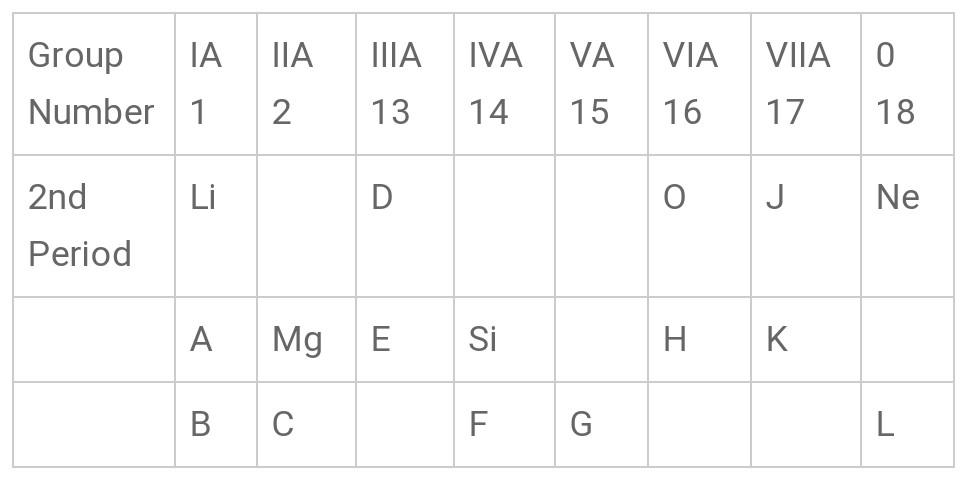
In the compound between A and H, what type of bond is formed?
(A) Ionic
(B) Covalent
(C) Coordinate
(D) No bond is formed
Answer
463.2k+ views
Hint: By looking in the below table, we would get an idea about which element is A and which is H. Determining their nature we can easily say what type of bond is formed between them.

Complete step by step solution:
From the table given above, we can see that A belongs to Group IA and H belongs to Group VIA. Since A is below Lithium (Li-Atomic No.3) and next Neon (Atomic No. 10), it must surely be Sodium (Na- Atomic No. 11). H is placed in Group VIA, before the potassium (K- Atomic No. 17), so it must be Sulphur (S) with Atomic Number 16. As we know Na is a metal and S is a Nonmetal, the bond formed between them must be an ionic bond and the compound is called Ionic compound.
Definition: Ionic bond is the force of attraction between a positive and negative ion. This bond will be formed when the metallic atom gives its electrons to the nonmetallic atom.
During this time metal will give its electrons to the nonmetal, in order to obtain the nearest stable electronic configuration. Similarly, nonmetal will also accept those electrons from the metals in order to obtain the nearest stable electronic configuration.
$2Na+S\to N{{a}_{2}}S$
Sodium metal by giving its electron will attain [Ne] configuration and Sulphur will obtain two electrons (one from each Na metal) to attain [Ar] configuration.
Therefore, the correct answer is option (A) Ionic.
Additional Information:
There are various other bonds. They are
- Covalent bond
- Coordinate bond
- Hydrogen bond
Note: Covalent bonds will be formed only between two nonmetals. Ionic bonds are formed between a metal and a nonmetal. Strength of ionic bonds depends on the difference of electronegativity of the bonded atoms.

Complete step by step solution:
From the table given above, we can see that A belongs to Group IA and H belongs to Group VIA. Since A is below Lithium (Li-Atomic No.3) and next Neon (Atomic No. 10), it must surely be Sodium (Na- Atomic No. 11). H is placed in Group VIA, before the potassium (K- Atomic No. 17), so it must be Sulphur (S) with Atomic Number 16. As we know Na is a metal and S is a Nonmetal, the bond formed between them must be an ionic bond and the compound is called Ionic compound.
Definition: Ionic bond is the force of attraction between a positive and negative ion. This bond will be formed when the metallic atom gives its electrons to the nonmetallic atom.
During this time metal will give its electrons to the nonmetal, in order to obtain the nearest stable electronic configuration. Similarly, nonmetal will also accept those electrons from the metals in order to obtain the nearest stable electronic configuration.
$2Na+S\to N{{a}_{2}}S$
Sodium metal by giving its electron will attain [Ne] configuration and Sulphur will obtain two electrons (one from each Na metal) to attain [Ar] configuration.
Therefore, the correct answer is option (A) Ionic.
Additional Information:
There are various other bonds. They are
- Covalent bond
- Coordinate bond
- Hydrogen bond
Note: Covalent bonds will be formed only between two nonmetals. Ionic bonds are formed between a metal and a nonmetal. Strength of ionic bonds depends on the difference of electronegativity of the bonded atoms.
Recently Updated Pages
Master Class 11 Accountancy: Engaging Questions & Answers for Success

Glucose when reduced with HI and red Phosphorus gives class 11 chemistry CBSE

The highest possible oxidation states of Uranium and class 11 chemistry CBSE

Find the value of x if the mode of the following data class 11 maths CBSE

Which of the following can be used in the Friedel Crafts class 11 chemistry CBSE

A sphere of mass 40 kg is attracted by a second sphere class 11 physics CBSE

Trending doubts
Define least count of vernier callipers How do you class 11 physics CBSE

The combining capacity of an element is known as i class 11 chemistry CBSE

Proton was discovered by A Thomson B Rutherford C Chadwick class 11 chemistry CBSE

Find the image of the point 38 about the line x+3y class 11 maths CBSE

Can anyone list 10 advantages and disadvantages of friction

Distinguish between Mitosis and Meiosis class 11 biology CBSE




